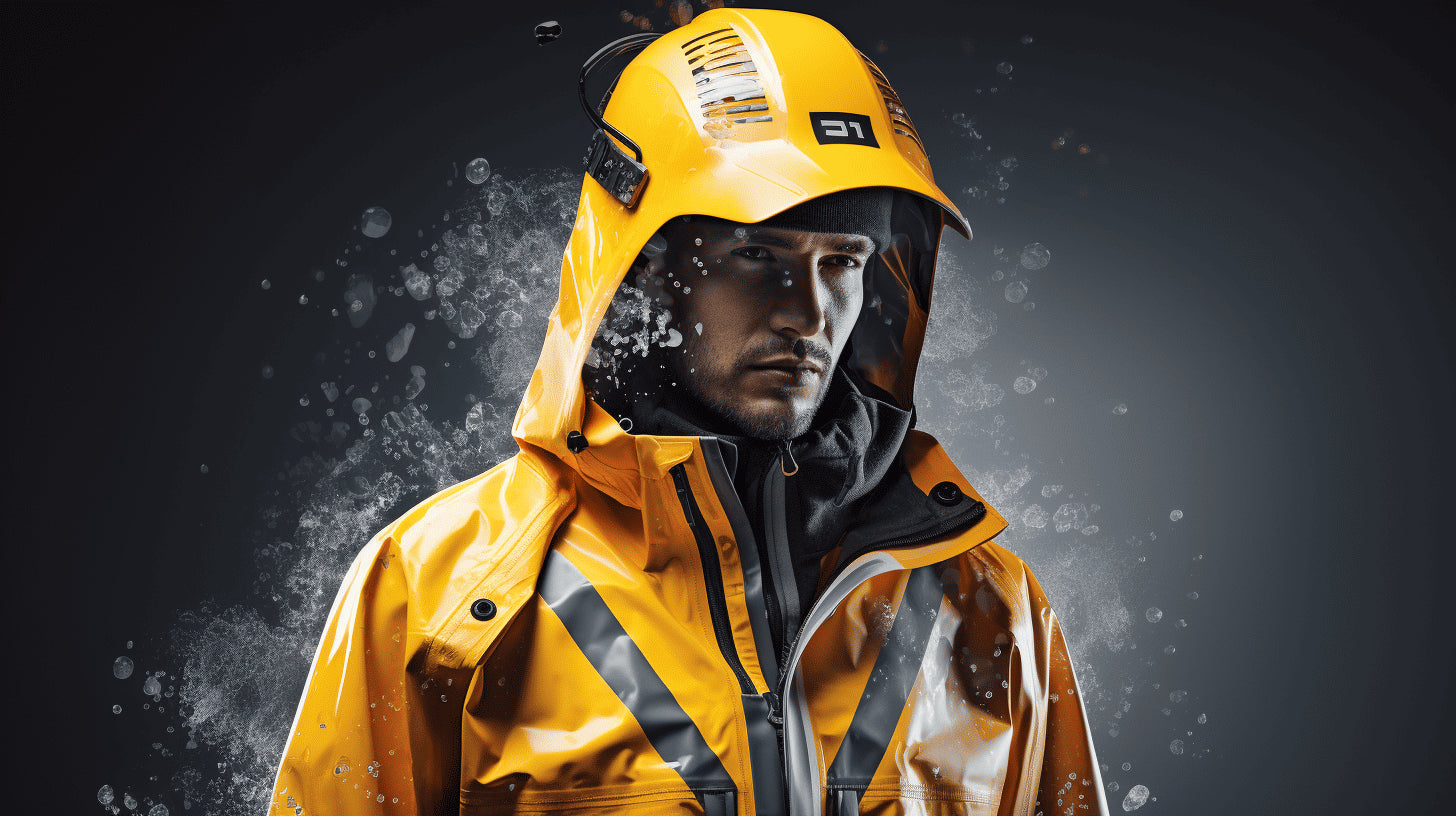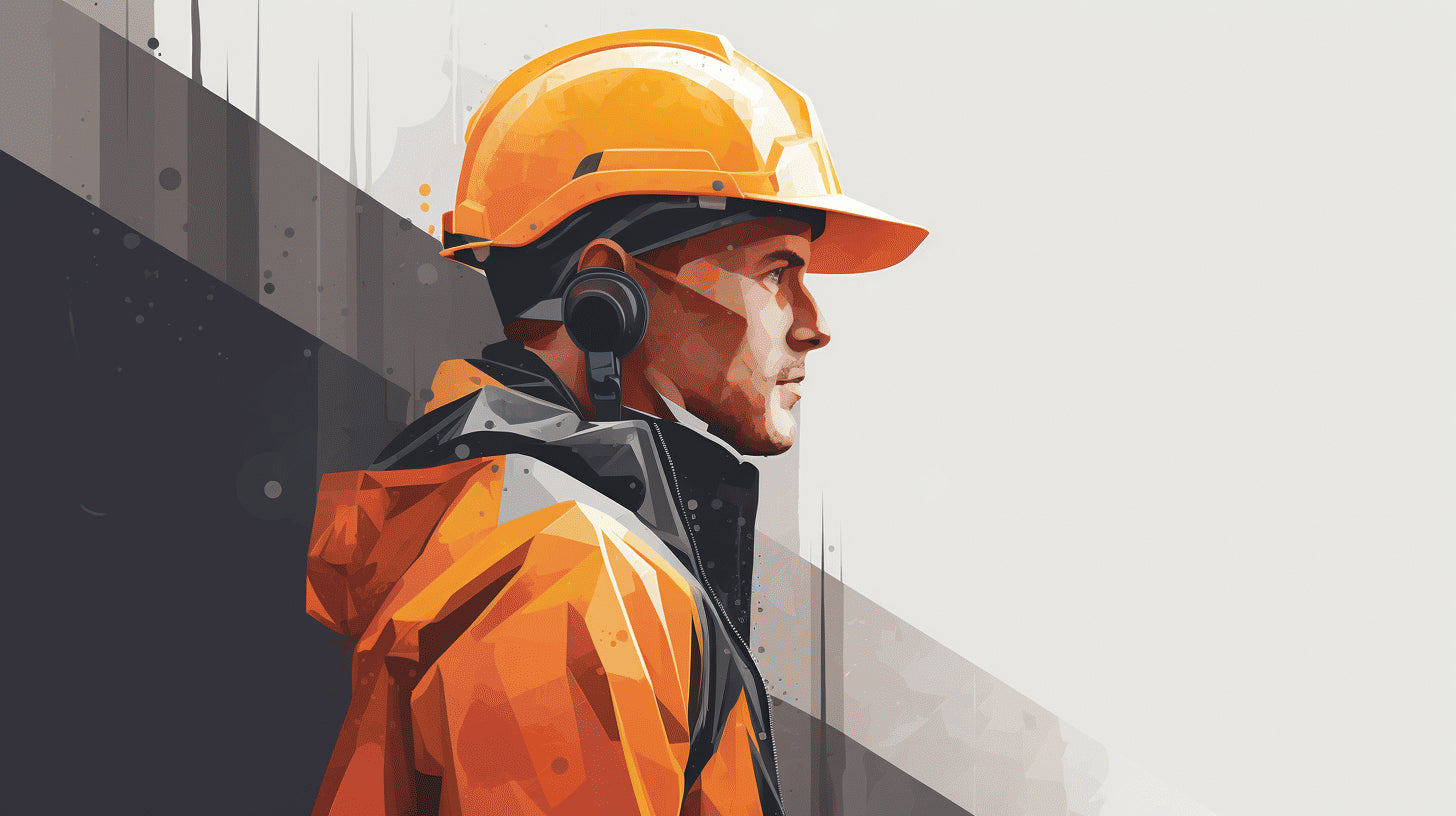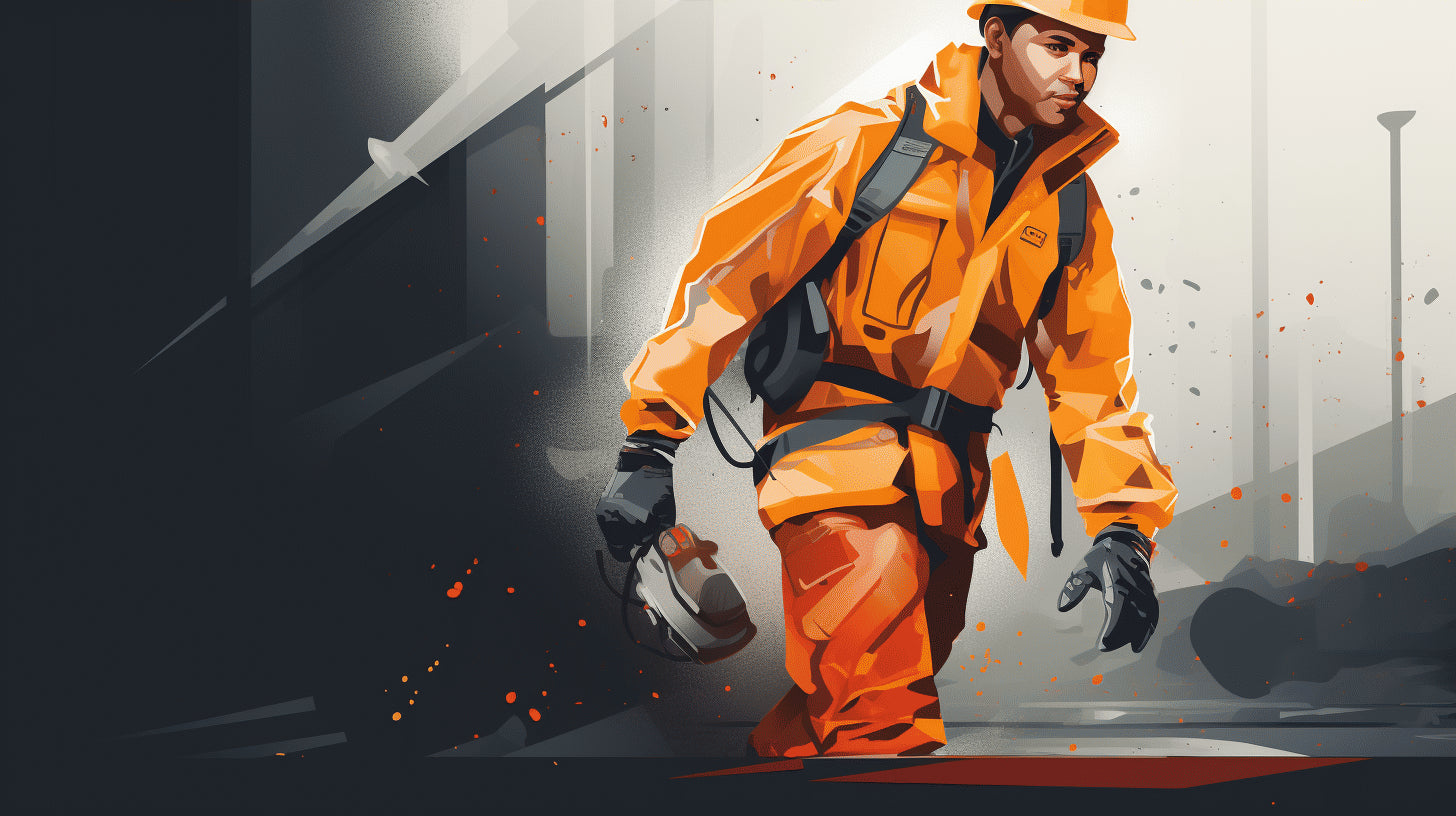From the bustling cities' skyscrapers to the country's majestic infrastructures, construction workers sail through various weather conditions, including the rain. Yet, nothing should hinder productivity, let alone a rain shower. With the right rain gear, builders can seamlessly continue their work, maintaining efficiency without sacrificing comfort and safety. However, this leads us to a critical question—what should comprise the 'right' rain gear? The answer lies within the nuances of rain gear materials and their durability.
In this article, we will take an in-depth look at different rain gear materials for construction workers, focusing on their durability. Alongside, we will explore factors like reinforced seam and zipper construction, safety considerations, and innovations in the field. This comprehensive guide aims to equip construction workers with the knowledge of rain gear materials, helping them make informed decisions and ultimately contribute to a safer, more comfortable work environment. Prepare your hard hats and let's dive deep into the world of durable rain gear materials.
Importance of Durability for Construction Rain Gear
Staying dry while on the job site is essential for construction workers, as working in wet conditions can lead to numerous health and safety issues. Ensuring that you have sturdy and durable rain gear should be a top priority. The importance of choosing durable construction rain gear cannot be overstated. But what exactly makes durability so important?
Why Durability Matters
Firstly, durable rain gear offers better protection. Construction sites can be harsh and demanding environments with a myriad of potential hazards. Having rain gear that can withstand these conditions meted out by the weather and the work environment in a sustainable manner is vital.
- Long-lasting protection: Durability often translates to the gear's longevity. The more robust the rain gear, the longer it will usually last, saving you from frequent replacement costs.
- Performance: High-quality, durable rain gear provides consistent protection against wet and windy weather, maintaining performance over time.
- Comfort and Safety: Comfort shouldn't be jeopardized while ensuring durability. Durable rain gear is constructed from materials that not only protect but are also comfortable to wear and move around in.
Remember, effective rain gear is paramount for a safe and comfortable working day, helping workers concentrate on their tasks rather than their discomfort.
Durability and Cost-Effectiveness
Sure, opting for high-quality, durable construction rain gear might hit your pocket at the initial purchase. However, over time, it will prove to be a cost-effective option. Consider the following:
- Longevity: As mentioned previously, durability equals longevity. Buy a durable product, and you won't have to worry about replacement costs for a good while.
- Performance: With lesser quality gear, your protection against harsh weather might diminish over time - meaning you'll need to replace it sooner.
- Health implications: Staying dry and comfortable can also prevent health issues associated with exposure to damp and cold conditions, saving potentially substantial medical costs in the future.
As the saying goes, "Buy cheap, buy twice." Therefore, investing in durable, high-quality gear can save you money in the long run.
Ensuring Durability
When looking for durable construction rain gear, pay attention to the construction, materials, and the reputation of the manufacturer. Consider the:
- Material: PVC, polyester, and nylon are all popular materials for rain gear due to their inherent water-resisting properties.
- Build Quality: The construction of the gear is as vital as the material. Look for reinforced seams, sturdy zippers, and secure attachments that ensure a long-lasting product.
- Manufacturer's reputation: Check out reviews and talk to other people in the industry about which brands or manufacturers are known for producing durable rain gear.
By keeping durability as your main focus while selecting your construction rain gear, you ensure a safer, more comfortable, and cost-effective experience on the battlefield known affectionally as a construction site! It's not a luxury, but a necessity. After all, as the grand old Bob Dylan once said, "You don't need a weatherman to know which way the wind blows."
Choosing the Right Rain Gear Material
When it comes to choosing the perfect rain gear, the material is key. The fabric not only needs to effectively ward off water but also be resistant to the elements, comfortable, breathable, and quite importantly, long-lasting. To help you with this, we're focusing on some options worth considering.
PU (Polyurethane)
First up, let's talk about PU, also known as polyurethane. This synthetic material has multiple desirable properties for rain gear: it's flexible, tear-resistant, and resilient against dirt and oil. These traits extend the lifespan of PU rain gear, paving the way for enduring utilitarian style.
ePTFE (Expanded Polytetrafluoroethylene)
A significant player in the high-end rainwear market is ePTFE, or expanded polytetrafluoroethylene. This material boasts superior durability, making it a favorite among outdoor enthusiasts who need gear that can withstand heavy downpours and harsh climates. While ePTFE may come with a slightly steeper price tag, the investment is often deemed worth it for its exceptional longevity.
Fluoropolymer Materials
Fluoropolymer materials offer the latest in rainwear technology. Specific fluoropolymers are now used in the construction of rain gear, bringing another level of durability to the table. Fluoropolymers have a unique ability to maintain their physical properties in a broad range of temperatures and environmental conditions, making them ideal for any weather.
PFC-free Materials
For those who place a premium on safety and sustainability, PFC-free materials and coatings offer an excellent choice. PFCs (Perfluorocarbons) are chemicals often used in fabric treatments to create water resistance. However, PFC-free gear ensures that you're not exposed to these potentially harmful substances, while also promoting more environmentally friendly production processes.
Polyester, Nylon, and PVC
Commonly used materials, such as polyester, nylon, and PVC, remain solid choices for rain gear. Known for their durability, water-resistance, and cost-effective nature, these fabrics are favorites among many users. Polyester is strong and quick-drying, nylon is lightweight and resilient, while PVC, though less breathable, provides an unparalleled water barrier.
In the end, choosing the right rain gear material really depends on what you're seeking: be it durability, safety, environmental responsibility, or all of the above. So, the next time you're on the hunt for that perfect raincoat or set of waterproof trousers, keep these materials in mind. They might just save you from a good soaking!
Reinforced Seam and Zipper Construction
When it comes to designing quality rain gear, durability is a top consideration. The difference between staying dry or getting soaked can often be chalked up to key features like reinforced seams and heavy-duty zippers.
You see, while the fabric undoubtedly plays a vital role in keeping the rain out, the sealing of potential entry points is equally crucial. That's where reinforced seams and zippers come into play. They work as formidable barriers that prevent water from seeping in.
Here's what you need to know about these vital components:
Reinforced Seams
Reinforced seams essentially have extra stitches or an additional layer of fabric strategically placed over a regular seam. The idea is to enhance the strength and waterproof capability of the garment.
The benefits are quite apparent:
- Increased durability: Reinforced seams are designed to withstand wear and tear, making them far less likely to fray or rip under duress.
- Enhanced waterproofing: With extra stitching or materials, water finds it harder to seep through, keeping you dry even in a downpour.
Heavy-duty Zippers
Zippers create potential points of entry for water; thus, they need to be adequately addressed. Heavy-duty zippers are often larger, stronger and have a more secure closing mechanism:
- Durability: These zippers are designed to resist damage and provide a long-lasting level of performance.
- Water-resistance: Many feature a layer of waterproofing material that helps lock out the rain, adding another layer of defense against wet weather.
So next time you're looking for rain gear, don't just consider the material. Check for the presence of reinforced seams and high-quality zippers. Because when the skies open up, you'll appreciate the added protection they afford.
What's that saying? "It's better to have it and not need it, than to need it and not have it." Trust us when we say it applies perfectly to the importance of durability in your weather gear.
These features aren't just about protection. They are a testament to quality and craftsmanship, extending the life of your gear, offering you value for more than just the rainy days. Indeed, in rain gear, reinforced seams, and zippers truly steal the show.
Considering Durability and Safety
From offshore oil platforms to urban construction sites, industries worldwide recognize the importance of high-quality rain gear. The main role of such gear is to provide protection from harsh weather conditions, keeping workers safe, comfortable, and efficient. However, there's more than just repelling rain that makes a piece of gear invaluable — durability and safety come into play, often becoming determining factors when choosing the right rain gear.
Built to endure, top-quality rain gear often relies on heavy-duty materials like PVC or neoprene. These materials provide superior durability and resistance to tears and abrasions, characteristics that go beyond ensuring longevity. This resilience is essential for environments where physical rhiss is high and unexpected contact with sharp or rough surfaces is part of the job.
To fully appreciate the importance of durability in rain gear, consider these points:
- Durability and safety are intertwined: The wear and tear on your gear can directly affect your protection level. Thus, the higher the durability, the better the safety.
- Resilient materials protect: PVC and neoprene, known for their resistance to tears and abrasions, can handle rough work conditions, reducing the risk of injury.
Apart from these, remember that durability of rain gear also directly affects its ability to protect workers from potential hazards. If a rain jacket wears out quickly and tears occur, it leaves the worker exposed, reducing the gear's ability to provide protection. This only underlines the importance of considering material strength and endurance during the selection process.
"Safety comes from proper gear; proper gear comes from quality materials."
In an industry where every decision can deeply impact safety, wisely choosing rain gear becomes an essential part of risk management. While protection from rain is indeed vital, considering factors like durability and resistance will only enhance safety and efficiency in the long run.
As you decide on the right rain gear, remember to give weight to durability and safety. It's not just about whether a jacket can keep you dry, but whether it can keep you safe in varied work environments. Both considerations do not exist in isolation; durability is an integral part of your rain gear's overall safety. Make sure you don't overlook this aspect as you brave the elements at your workplace.
Role of Waterproof Materials and Coatings
It's no mystery that weather conditions can be unpredictable, plunging us from a sunny afternoon into a heavy downpour without much warning. In such situations, the role of waterproof materials and coatings escalates significantly. So consider these unsung heroes for a moment, which uncomplainingly weather the storms with you, keeping you dry, comfortable, and worry-free.
Among an array of waterproof substances, DWR, or Durable Water Repellent, deserves particular attention. This powerful coating is commonly applied to rain gear such as jackets, trousers, and tents. It's known for its stellar performance in preventing moisture absorption, hence extending the lifespan of your favorite rain-ready pieces.
DWR (Durable Water Repellent)
Imagine full protection, even when an unexpected rainstorm hurls water at you. The Durable Water Repellent (DWR) has you covered. DWR is a coating applied to fabrics that funnels water off the material, preventing it from hampering functionality and comfort. It's a weather-repelling wizard that keeps rain gear durable and long-lasting.
- Performance: The DWR coating works magically, transforming the gear into a water-repelling shield. Raindrops simply roll off the gear, leaving you comfortably dry.
- Durability: The ‘Durable’ in DWR isn’t there for show. This coating is known to repel water for an extended period before requiring reapplication.
- Protection: Unlike several waterproofing materials that only resist water, DWR acts as a reliable armor against oil and stains as well. This makes it a versatile choice for various applications beyond rain garments.
Incorporating the extra information you've provided, let's understand better how DWR contributes to the durability of rain gear. By preventing moisture absorption, DWR inhibits the material's weakening due to dampness, making them withstand several bouts of heavy rain while retaining their initial quality.
The stunt of waterproof materials and coatings may seem simple, but their utilization is profound. You'll find them silently working away in not just your rain gear, but your hiking boots, your camping tents, and any other gear that needs to bear the brunt of the elements. From keeping us dry to extending the gear's lifespan, waterproof materials stand as silent guardians, ensuring we face the world's uncertainties with confidence and comfort.
Advancements in Rain Gear Materials and Construction
Fashion and function come together in the realm of rain gear as steady advancements in materials and construction continue to redefine our understanding of durable rainwear. The evolution of technology has made staying dry in the wettest conditions a breeze. With developers continually pushing the boundaries in design and fabric, rain gear has changed substantially over the last few decades. Let's delve deeper into some of these transformative advancements.
First, synthetic materials have revolutionized the rain gear arena. From nylon to Gore-Tex, these materials have brought about a sea change in how rain gear is designed and manufactured. Synthetic materials offer superior strength and durability, making them an ideal choice for rainwear.
- Nylon, for instance, is not only extremely abrasion-resistant but also incredibly lightweight, making it a go-to material for rainwear manufacturers.
- Gore-Tex is another game-changing synthetic material. This waterproof material allows sweat and humidity to escape, thus keeping the wearer dry and comfortable from the inside out.
Next, construction techniques have seen significant enhancements, especially in terms of the introduction of sealed seams. Traditionally, the joints or seams of rain gear were the weakest points where water could seep in. However, modern sealing techniques have overcome this weakness, leading to fully waterproof garments.
- Taped seams involve a waterproof tape being applied over the seams, thus preventing water from entering through the stitches.
- Welded seams, on the other hand, fuse the material together without the use of stitches, entirely eliminating the possible ingress points for water.
Lastly, the invention and application of durable water-repellent finishes have minimized water absorption, allowing fabrics to remain light and breathable even during heavy rainfall.
As seen from these developments, innovations in rain gear materials and construction techniques are constantly improving the durability of rainwear. The future of rain gear looks promising, with technology expected to catalyze more groundbreaking advancements. Devotees of the great outdoors, rejoice! The evolution of rain gear assures your pursuits, undeterred by the rain, are more comfortable and enjoyable than ever.
Conclusion: The Vital Role of Durability in Worker Comfort and Safety
As we have taken a deep dive into the world of robust and weather-resistant rain gear, the central role of durability becomes undeniable in ensuring the comfort and safety of construction workers. A stitch in time not just saves nine, but also shields from unpredictable climate changes - and that's the power of high-quality, long-lasting rain gear.
Selecting the right rain gear material causes a ripple effect that touches multiple aspects of a worker's daily grind at the job site. The domino effect of choosing quality rain gear includes improved safety, enhanced workplace productivity, and boosted worker morale. And all these benefits are hallmarks of a professional space that values its workers and their contributions.
The strength of a product finds its roots in the quality of its individual elements, and so does the strength of a worker's protection during a downpour. Layers like PU, ePTFE, or Fluoropolymer materials; suit enhancements with DWR application; and reinforced seams and zipper constructions merge to create armor that invites the storm without flinching.
Naturally, when it comes to durable gear that's constructed with longevity and overall user safety in mind, Hurricane Raingear stands out as a premier choice. Handcrafted in the Pacific Northwest and made of 100% North-America-Made materials, our rain gear sweeps the floor with adverse weather conditions no matter how relentless they may be.
Remember, durability in your rain gear echoes your durability in the field; don't compromise on it in your quest for optimal worker comfort and safety. As in construction, so in rain gear — durability goes a long way in weathering any storm that might come your way.
Frequently Asked Questions
-
What are the most durable rain gear materials for construction workers?
The most durable rain gear materials for construction workers are PVC (polyvinyl chloride), polyurethane, and Gore-Tex. These materials are known for their excellent waterproofing capabilities and resistance to wear and tear.
-
Are PVC rain gear materials suitable for construction workers?
Yes, PVC rain gear materials are highly suitable for construction workers. They are waterproof, affordable, and provide good protection against harsh weather conditions and hazards on the job site.
-
What are the advantages of using polyurethane rain gear materials?
Polyurethane rain gear materials offer several advantages for construction workers. They are lightweight, flexible, durable, and have excellent resistance to abrasions, oils, and chemicals.
-
Is Gore-Tex rain gear material worth the investment for construction workers?
Yes, Gore-Tex rain gear material is worth the investment for construction workers. It is highly durable, breathable, and waterproof, making it suitable for demanding work environments where comfort and protection are crucial.
-
How can construction workers ensure the durability of their rain gear materials?
To ensure the durability of rain gear materials, construction workers should follow the manufacturer's care instructions, avoid exposing the gear to excessive heat or chemicals, regularly inspect for damages, and promptly clean and dry the gear after use.























Leave a comment
This site is protected by hCaptcha and the hCaptcha Privacy Policy and Terms of Service apply.